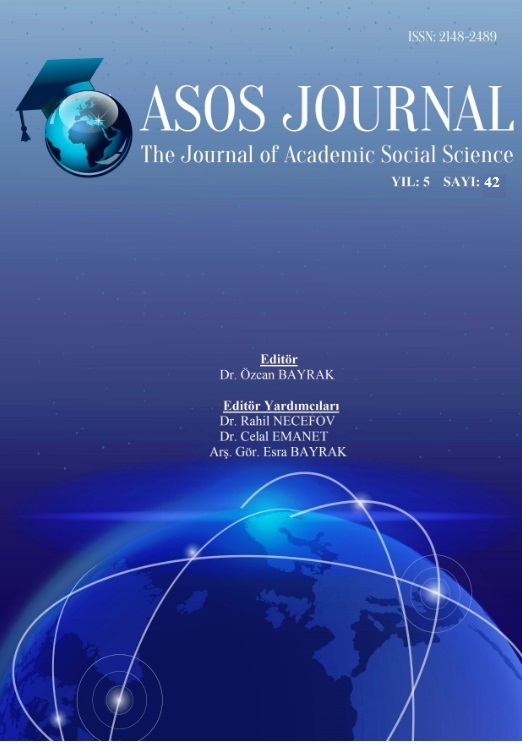Author :
Abstract
Bu araştırmanın ana eksenini, on yedinci yüzyılın başlarında erken modernitenin, toplumu ve sanatı şekillendirdiği bir dönemde karşımıza çıkan beş duyu resimleri oluşturmaktadır. İnsanı tanımlayan beş duyuya (görme, işitme, koklama, dokunma ve tatma) bu dönemde hümanist ve bilimsel açıdan bir ilgi uyanmaya başlamıştır. Anatomi, tıp ve felsefe ve toplumbilimin yanında, beş duyu konusu, görsel sanatların da odak noktasına dönüşmüştür. Hümanist ve felsefi açıdan yaklaşıldığında, insan kimliğinin yapı taşı olan bu beş duyu, resim sanatında; geleneksel bir din inancının yansıması olarak anlam kazanmıştır. Sanatta Anlamın Görüntüsü isimli kitabında Richard Leppert beş duyu konulu resimleri, öbür dünya çerçevesinde düşünüldüğünde anlam kazanan formlar olarak yorumlamakta ve kutsal kitaplarda yer alan bir imge alfabesinden söz etmektedir. Bu beş duyunun, kutsal kitaplarda yer alan temsil edilme şekilleri ise, “Kartalın simgelediği görme; İsa’nın kör bir adama şifa vermesi teması ile, ayna; Adem’le Havva’nın Cennetten kovulması temasıyla, işitme; Vaftizci Yahya’nın vaazıyla, tatma; beş bin kişiyi doyuran ekmek mucizesi ile, koklama; Bakire Meryem’in, İsa’nın ayaklarını yağlayarak kutsamasıyla ve dokunma da İsa’nın su üstünde yürümesi mucizesiyle bağlantılıydı”. Bununla birlikte sanatçının beş duyuyu ele alış biçimi, imgeler alfabesinin belirlediği kodlamalar ile değil, nadire kabinelerine benzer bir şekilde nesneler envanterine dönüşür. XVII.yüzyılda beş duyu konulu resimleri ele alan sanatçılardan en başta geleni Flaman asıllı sanatçı Büyük Jan Brueghel’dir. Sanatçının tablolarında her bir duyuya ayrı hitap eden yaklaşımlar bulunmaktadır. Kendisinin, 1617-1618 yılları arasında yaptığı “İşitme” isimli tablosu, dünyevi hazlara hizmet eden sayısız kültürel değerlere sahip eşyalar ve çıplak bir kadın bedeninden oluşmaktadır. Tabloda yer alan başroldeki müzik aletleri, kadınla yanı eksende yer almakta dolayısıyla işitme ve bakma isteği, izleyiciyi aynı anda tetiklemektedir. Bu resimler, “Bizatihi bakma edimine” hizmet ederler ya da başka bir deyişle gözlerin kulağıdır. Bu bağlamda beş duyu resimleri arasında yer alan “İşitme” teması, özellikle 17. Yüzyıl Avrupa resim sanatında temsil boyutlarıyla okunmalıdır. İmgeler asıl dünyayı değil, başka dünyaları, başka algı boyutlarını yaratırlar. Gösterilmek istenilen şey, salt bir müzik aleti değil, bunun temsilidir. Bu çerçeveden, ister resim, ister video ya da bir fotoğraf, imgelerden oluşur ve o da kapısını insan bilincine açar. İnsan bilinci de şüphesiz ki; kültürün ve tarihin ayrılmaz bir parçası ile biçimlendiği için, tüm bu eserler; belli bir sosyokültürel tabakaya, belli bir anlam yüklenerek, inşa edilmiş olan temsillerdir.
Keywords
Abstract
Drawings of the five senses that appeared at the beginning of the 17th century when the early modernity shaped the society and the art constitute the main axis of this study. In this period, a humanist and scientific interest was inspired for the five senses (sight, hearing, smell, touch and taste) that define the human being. The topic of the five senses was transformed into the focus point of visual arts in addition to its position in anatomy, medicine, philosophy and sociology. In terms of humanist and philosophot@hical aspects, the five senses that are the building blocks of the human identity gained a new meaning in art of drawing as the reflection of traditional religious beliefs. In his book titled “Art and the Committed Eye”, Richard Leppert interprets the drawings on the five senses as the forms that become meaningful when they are thought in terms of the afterlife and mentions an alphabet of images that exist in holy books. How the five senses are represented in the holy books is represented in the following manner: “sight as represented with the Eagle is related to Jesus’ miracle of healing a man born blind and the mirror is related to Adam and Eve who were expelled from Eden; hearing is represented with the sermon of John the Baptist; taste is represented with the miracle of the Feeding of the 5,000; smell is represented with Mary Magdalena who anointed Jesus' feet with nard; and touch is related to the Jesus’ miracle of walking on water”. Jan Brueghel the Elder with Flemish descent is the leading artist who embraced the five senses in his drawings in the 17th century. There are approaches in the artist’s drawings that addressed each of the senses separately. His drawing titled “the Sense of Hearing”, completed in the years 1617-1618 is composed of various cultural instruments that serve earthly pleasures and the nude body of a female. The musical instruments in the drawing with leading roles appear side by side with the female and therefore the desires of hearing and sight stimulate the viewer at the same time. These types of drawings “actually” serve the “action of sight” or in other words, they are the ears of the eyes. In this context, the “hearing” theme included in the drawings related to the five senses should be understood with the dimensions of representation especially in 17th Century European Drawing. The images create not the real world, but other worlds, other dimensions of perception. What is shown is not a mere musical instrument but its representation. In this framework, whether it is a drawing, a video or a photograph, everything is formed by images which open their doors to human conscience. Since, undoubtedly, human conscience is shaped by the inseparable parts of culture and history, all these works are the representations that are built by assigning a specific meaning to a specific socio-cultural strata.





